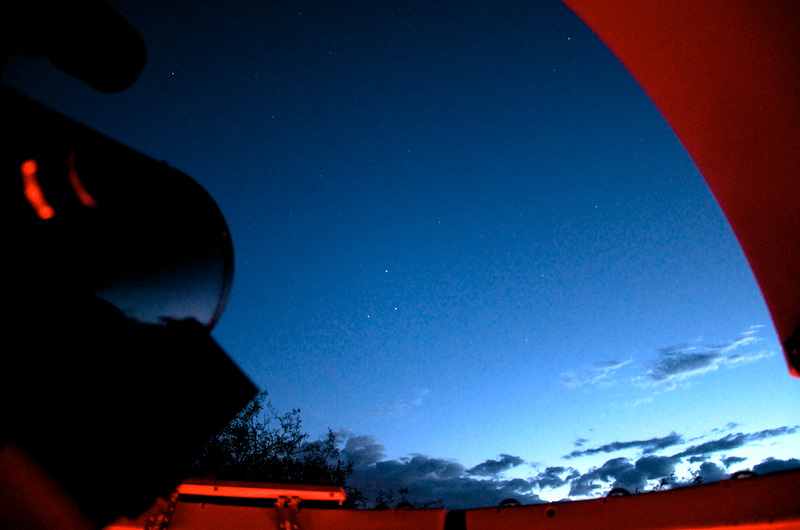
Crepuscular Rays, M102, and NGC6946;
Some Meteor Watching
Posted: 11 August 2012
As sunset approached on Friday, 10 August 2012, there were clouds in the south through northwest. They seemed to be moving towards the northwest so I opened the observatory at 1906 MST, 101°F. At 1917 MST, took this photograph of the western sky and Cassiopeia Observatory:

Crepuscular Rays after sunset were becoming quite evident and extended all the way to the southeast. At 1927 MST, I took this panoramic photograph with the iPhone and Photosynth showing the (distorted) view from the southeast (left) to the west (right):

The 8" LX200-ACF was powered on at 1935 MST and slewed to Saturn. Seeing was not very good but Titan was visible at 77X. At 1940 MST, Saturn, Spica, and Mars were visible to the naked eye, forming almost a perfect right triangle. At 1941 MST, the moon Rhea became visible at 77X. At 1955 MST, I took this handheld photograph of the sky from inside the observatory with the D7000 DSLR, f/3.5, 1 second, ISO 500, 18mm, showing Saturn, Spica, and Mars:

I also used the iPhone 4 to capture Saturn, Spica, and Mars using the "True NightVision" iOS app:

Some of the "stars" in the image are digital noise, but the right triangle of Saturn, Spica, and Mars is clearly shown.
At 2018 MST, slewed the 8" telescope to M102, a nice galaxy. It was a nice view at 77X. The clouds were still in the south-to-northwest and would not interfere with imaging. I mounted the D7000 DSLR at prime focus + Off-Axis Guider and did a focus test on Arcturus with the Bahtinov Mask. I returned to M102 and did two 1 minute ISO 6400 framing test exposures while searching for a guide star. I found a faint one and was able to capture this 5 minute, guided (but not perfectly), ISO 6400, slightly cropped image of the M102 galaxy:

I then slewed to NGC6946, a large but faint galaxy. Found a good guide star and did a 1 minute framing test exposure. I then took this 5 minute, guided, ISO 6400 image (cropped to about the same scale as the M102 image):

Due to the galaxy's faint magnitude, I removed the saturation from the image to bring out the spiral arms.
I ended imaging but still hoped to image M57, the Ring Nebula, later in the session. I began watching the sky looking for meteors from the Perseid Meteor Shower. There were still clouds south-to-west. At 1943 MST, saw two bright non-Perseid meteors moving towards the north. I continued sky watching until 2309 MST. I also viewed M31, the Great Andromeda Galaxy and the Double Cluster using 7x50 binoculars. Lightning flashes from a storm to the southwest would occasionally light up the entire sky. Clouds began nearing the zenith at 2236 MST and finally covered most of the southern half of the sky by 2245 MST. I decided I would not get any more DSO imaging done this night and PARKed the telescope. By 2309 MST, clouds were in most of the sky. During the little over one hour that I was able to sky watch, I saw 2 Perseid meteors and 7 non-Perseid meteors.
Due to the clouds, I closed the observatory at 2320 MST, 81°F.
Comments are welcome; use the Comments section below, or you can Email Me. Thanks.
Go to the previous report.
Return to the Cassiopeia Observatory Welcome Page.